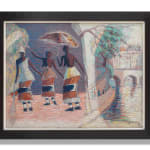Gerard Sekoto South African, 1913-1993
Further images
In 1966 Gerard Sekoto visited Dakar with his friend, the Brazilian artist Wilson Tiberio, to participate in the Congress of Negro Artists. According to his diaries and journals, Sekoto’s time in Senegal was a mix of experiences. The prominence of Islam and the challenges of understanding the French dialect heightened his sense of being a tourist and an outsider. During his stay, Leopold Senghor, the president of Senegal, loaned Sekoto his car, enabling him to explore the Casamance region in southern Senegal.
Sekoto remarked, "This part is called Casamance, where people have remained in their old African customs. They are much more welcoming to foreigners and are living in various ethnic groups with their vernacular dialects. They would go out of their way to do well to a visitor, but without the intention to extract material gain. In this way, they differed much from those people in big cities."
During his two-month stay in Casamance, Sekoto documented traditional dances and ceremonies through sketches. He described one event:
"This is a particular dance of the women in Casamance. There was a gathering over the death of a young man bitten by a snake. A cow and a bull were sacrificed with a few chickens during this dance of the women. The whole ceremony lasted a day and a great part of the night. All the gestures and structures in the build of these people are very different from our women in South Africa."
Although Sekoto had left Senegal by the time he painted "The Casamance Dancers and the River Seine" in 1975, his time in Casamance left a lasting impression on his work. The painting combines African cultural elements with European influences, depicting dancers from Casamance alongside the River Seine, a representation of Paris and Western culture. This blend of influences reflects Sekoto’s dual identity as an African artist living in exile.
Created in a post-impressionist style, this painting features bold brushstrokes and vibrant colours that convey movement. Warm earth tones highlight the dancers, while cooler blues and greens frame the Seine, creating a balance between the figures and the background. The composition draws the viewer’s focus from the dancers in the foreground to the bridge’s arches and the tranquil river beyond.
This painting demonstrates Sekoto’s mastery of integrating personal, cultural, and geographic themes. His memories and sketches from Senegal continued to influence his art throughout his career, emphasising the deep connection he had to his African heritage and his adaptability as an artist in exile.







